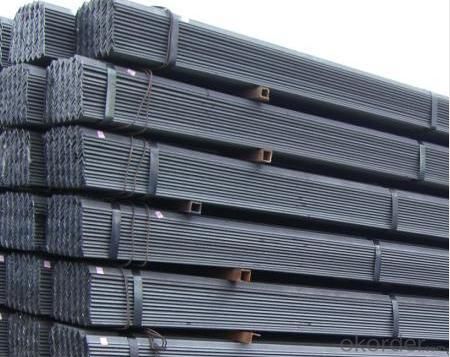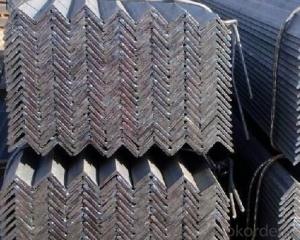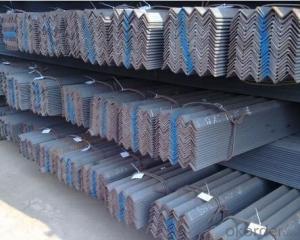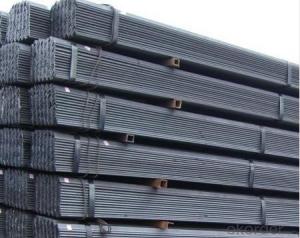Stainless Angle Steel with High Quality of GB Q235
- Loading Port:
- China Main Port
- Payment Terms:
- TT or LC
- Min Order Qty:
- -
- Supply Capability:
- -
OKorder Service Pledge
OKorder Financial Service
You Might Also Like
Product Description:
OKorder is offering Stainless Angle Steel with High Quality of GB Q235 at great prices with worldwide shipping. Our supplier is a world-class manufacturer of steel, with our products utilized the world over. OKorder annually supplies products to European, North American and Asian markets. We provide quotations within 24 hours of receiving an inquiry and guarantee competitive prices.
Product Applications:
Stainless Angle Steel with High Quality of GB Q235 are ideal for structural applications and are widely used in the construction of buildings and bridges, and the manufacturing, petrochemical, and transportation industries.
Product Advantages:
OKorder's Stainless Angle Steel with High Quality of GB Q235 are durable, strong, and resist corrosion.
Main Product Features:
· Premium quality
· Prompt delivery & seaworthy packing (30 days after receiving deposit)
· Corrosion resistance
· Can be recycled and reused
· Mill test certification
· Professional Service
· Competitive pricing
Product Specifications:
1. Standards: GB,ASTM,BS,AISI,DIN,JIS
2. Invoicing on theoretical weight or actual weight as customer request
3. Material:Material: GB Q235B, Q345B or Equivalent; ASTM A36; EN 10025, S235JR, S355JR; JIS G3192, SS400; SS540.
4. Sizes:
Sizes: 25mm-250mm | ||
a*t | ||
25*2.5-4.0 | 70*6.0-9.0 | 130*9.0-15 |
30*2.5-6.6 | 75*6.0-9.0 | 140*10-14 |
36*3.0-5.0 | 80*5.0-10 | 150*10-20 |
38*2.3-6.0 | 90*7.0-10 | 160*10-16 |
40*3.0-5.0 | 100*6.0-12 | 175*12-15 |
45*4.0-6.0 | 110*8.0-10 | 180*12-18 |
50*4.0-6.0 | 120*6.0-15 | 200*14-25 |
60*4.0-8.0 | 125*8.0-14 | 250*25 |
5. Material details:
Alloy No | Grade | Element (%) | |||||
C | Mn | S | P | Si | |||
|
|
|
|
|
|
| |
Q235 | B | 0.12—0.20 | 0.3—0.7 | ≤0.045 | ≤0.045 | ≤0.3 | |
|
|
|
|
|
|
| |
Alloy No | Grade | Yielding strength point( Mpa) | |||||
Thickness (mm) | |||||||
≤16 | >16--40 | >40--60 | >60--100 | ||||
≥ | |||||||
|
|
|
|
|
| ||
Q235 | B | 235 | 225 | 215 | 205 | ||
Alloy No | Grade | Tensile strength (Mpa) | Elongation after fracture (%) | ||||
Thickness (mm) | |||||||
| ≤16 | >16--40 | >40--60 | >60--100 | |||
≥ | |||||||
|
|
|
|
|
|
| |
Q235 | B | 375--500 | 26 | 25 | 24 | 23 | |
Usage & Applications of GB Q235 Angle Steel
Trusses;
Transmission towers;
Telecommunication towers;
Bracing for general structures;
Stiffeners in structural use.
Packaging & Delivery of GB Q235 Angle Steel
1. Transportation: the goods are delivered by truck from mill to loading port, the maximum quantity can be loaded is around 40MTs by each truck. If the order quantity cannot reach the full truck loaded, the transportation cost per ton will be little higher than full load.
2. With bundles and load in 20 feet/40 feet container, or by bulk cargo, also we could do as customer's request.
3. Marks:
Color mark: There will be color marking on both end of the bundle for the cargo delivered by bulk vessel. That makes it easily to distinguish at the destination port.
Tag mark: There will be tag mark tied up on the bundles. The information usually including supplier logo and name, product name, made in China, shipping marks and other information request by the customer.
If loading by container the marking is not needed, but we will prepare it as customer request.
FAQ:
Q1: Why buy Materials & Equipment from OKorder.com?
A1: All products offered byOKorder.com are carefully selected from China's most reliable manufacturing enterprises. Through its ISO certifications, OKorder.com adheres to the highest standards and a commitment to supply chain safety and customer satisfaction.
Q2: How do we guarantee the quality of our products?
A2: We have established an advanced quality management system which conducts strict quality tests at every step, from raw materials to the final product. At the same time, we provide extensive follow-up service assurances as required.
Q3: How soon can we receive the product after purchase?
A3: Within three days of placing an order, we will begin production. The specific shipping date is dependent upon international and government factors, but is typically 7 to 10 workdays.
Q4: What makes stainless steel stainless?
A4: Stainless steel must contain at least 10.5 % chromium. It is this element that reacts with the oxygen in the air to form a complex chrome-oxide surface layer that is invisible but strong enough to prevent further oxygen from "staining" (rusting) the surface. Higher levels of chromium and the addition of other alloying elements such as nickel and molybdenum enhance this surface layer and improve the corrosion resistance of the stainless material.


- Q:Can steel angles be used for manufacturing door frames?
- Yes, steel angles can be used for manufacturing door frames. Steel angles are commonly used in construction applications due to their strength and durability. They provide structural support and can be easily welded or bolted together to form a sturdy frame. Steel angles also have the advantage of being resistant to corrosion, which is important for door frames that are exposed to the elements. Additionally, steel angles can be customized to specific measurements and shapes to fit the desired design and dimensions of the door frame. Overall, steel angles are a reliable and popular choice for manufacturing door frames.
- Q:Can steel angles be used for platform structures?
- Yes, steel angles can be used for platform structures. Steel angles are commonly used in construction for their strength, durability, and versatility. They provide structural support and stability to various types of platforms, including elevated walkways, mezzanines, catwalks, and scaffolding. Steel angles offer excellent load-bearing capacity and can withstand heavy loads, making them suitable for platform structures that require a high level of strength and stability. Additionally, steel angles can be easily fabricated and joined together, allowing for efficient construction and customization of platform structures.
- Q:How do you calculate the shear capacity of a steel angle?
- In order to determine the shear capacity of a steel angle, several factors must be taken into account. Firstly, the material properties must be considered. This involves determining the yield strength of the steel angle, which signifies the maximum stress the material can endure before permanent deformation occurs. Next, the cross-sectional area of the steel angle needs to be measured. This can be accomplished by calculating the width and thickness of the angle and multiplying them together. The shear stress applied to the angle can then be calculated by dividing the applied force by the cross-sectional area. To assess the shear capacity, the calculated shear stress is compared to the yield strength of the steel angle. If the shear stress is lower than the yield strength, the angle is deemed safe and capable of withstanding the applied force. Conversely, if the shear stress exceeds the yield strength, the angle may fail and deform. It should be noted that different design codes and standards may have specific equations or factors to be taken into consideration when determining the shear capacity of a steel angle. Therefore, it is advisable to consult the relevant design code or seek assistance from a structural engineer to ensure accurate and secure calculations.
- Q:How do steel angles compare to other structural shapes like beams and channels?
- Construction and engineering projects often utilize steel angles, beams, and channels as structural shapes. These shapes each possess distinct characteristics and advantages, but steel angles specifically offer unique benefits that contribute to their popularity. The versatility of steel angles is a key advantage. They can be employed in various applications, such as supporting heavy loads, bracing structures, and creating frameworks. With their L-shaped design, steel angles can be easily joined together through welding or bolting to construct larger structures or frameworks. In terms of cost-effectiveness, steel angles tend to be more economical compared to steel beams. They require less material for manufacturing, making them a more budget-friendly option for projects with financial constraints. Furthermore, steel angles are typically lighter in weight than beams, which can be advantageous for transportation and installation expenses. On the other hand, steel channels provide similar benefits to steel angles but possess a distinct shape. Channels possess a U-shaped design, offering enhanced stability and support. They are commonly utilized in applications that demand increased strength, such as the construction of bridges, buildings, and machinery. While steel angles may not offer the same level of strength and load-bearing capacity as steel beams or channels, they remain a reliable choice for numerous structural applications. Their versatility, cost-effectiveness, and ease of installation make them a preferred option for a broad range of construction and engineering projects.
- Q:Can steel angles be used for support brackets in electrical installations?
- Indeed, support brackets for electrical installations can certainly utilize steel angles. In construction, steel angles are frequently employed and offer robust support for a multitude of applications, including electrical installations. These angles possess impressive strength and durability, enabling them to withstand the weight and stress imposed by supporting electrical components or fixtures. Furthermore, steel angles can be effortlessly affixed to walls, ceilings, or alternative surfaces, thereby establishing a reliable foundation for electrical equipment such as junction boxes, conduit, or cable trays. Furthermore, steel angles can be tailored and fabricated to accommodate precise installation specifications, rendering them an adaptable selection for support brackets in electrical installations.
- Q:What are the considerations for selecting the appropriate steel angle length?
- When selecting the appropriate steel angle length, there are several considerations to keep in mind. Firstly, the intended application and usage of the steel angle should be considered. This includes factors such as the load-bearing capacity required, the structural design of the project, and any specific engineering or architectural requirements. Secondly, the dimensions and measurements of the project should be taken into account. This involves considering the overall size and shape of the structure, as well as the specific location and orientation where the steel angle will be installed. Additionally, the availability and cost of different steel angle lengths should be considered. It is important to assess the cost-effectiveness and availability of different lengths to ensure that the chosen length aligns with the project budget and timeframe. Lastly, it is crucial to consult industry standards and regulations when selecting the appropriate steel angle length. Adhering to specific guidelines and codes ensures the safety and compliance of the structure, and helps to avoid any potential issues or risks in the future. By considering these factors, one can make an informed decision when selecting the appropriate steel angle length for their specific project.
- Q:What's the size of the 50 angle iron?
- Angle called angle, the steel strip is perpendicular to each other on both sides into the corner. There are equal angles and unequal angles. The two sides of an equal angle steel are equal in width.The specifications are expressed in millimeters of edge width * edge width * edge thickness. Such as "/ 30 x 30 x 3", that is 30 mm equilateral angle edge width edge thickness was 3 mm. Also available models that model is the number of centimeters wide, such as angle 3#. The model does not mean the size of the different edges and sizes of the same model. Therefore, the width, the edge and the thickness of the angle iron should be filled out in the contract and other documents, so as not to be indicated by the model alone. Standard Specification for hot-rolled equal angle iron is 2#-20#.
- Q:Can steel angles be painted or coated after installation?
- Yes, steel angles can be painted or coated after installation. Painting or coating steel angles after installation can provide additional protection against corrosion and enhance their aesthetic appeal. Prior to painting or coating, it is important to clean and prepare the surface by removing any dirt, rust, or contaminants. This can be done through techniques such as sandblasting, wire brushing, or using chemical cleaners. Once the surface is clean and dry, a suitable primer can be applied to promote adhesion and prevent corrosion. After the primer has dried, a final coat of paint or coating can be applied using a brush, roller, or spray. It is essential to choose a paint or coating that is specifically designed for steel and offers the desired level of protection and durability.
- Q:Are steel angles resistant to chemical exposure?
- Yes, steel angles are generally resistant to chemical exposure. However, the level of resistance can vary depending on the specific type of steel used and the type and concentration of the chemicals involved. It is important to consult with experts or refer to material compatibility charts to determine the suitability of steel angles for specific chemical environments.
- Q:Are steel angles available in non-standard dimensions?
- Yes, steel angles are available in non-standard dimensions.
1. Manufacturer Overview |
|
|---|---|
| Location | |
| Year Established | |
| Annual Output Value | |
| Main Markets | |
| Company Certifications | |
2. Manufacturer Certificates |
|
|---|---|
| a) Certification Name | |
| Range | |
| Reference | |
| Validity Period | |
3. Manufacturer Capability |
|
|---|---|
| a)Trade Capacity | |
| Nearest Port | |
| Export Percentage | |
| No.of Employees in Trade Department | |
| Language Spoken: | |
| b)Factory Information | |
| Factory Size: | |
| No. of Production Lines | |
| Contract Manufacturing | |
| Product Price Range | |
Send your message to us
Stainless Angle Steel with High Quality of GB Q235
- Loading Port:
- China Main Port
- Payment Terms:
- TT or LC
- Min Order Qty:
- -
- Supply Capability:
- -
OKorder Service Pledge
OKorder Financial Service
Similar products
New products
Hot products
Hot Searches
Related keywords




























